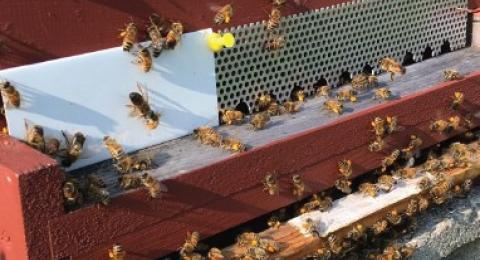
Managed honey bee colonies in New Hampshire face many challenges that affect the ability of a colony of bees to survive and reproduce. These include mites, nosema, foulbrood as well as pesticide exposure, genetic challenges, drought and environmental changes. Each year, it seems there are more challenges added to the list. Similar to human health, a diverse diet rich in carbohydrates, protein, vitamins and amino acids has been proven to improve the longevity of the honey bee. The honey and pollen put away by the bees in the summer must last through the winter until the snow recedes and the first flowers come out. One solution to improving the health and survivability of honey bee colonies is to improve their nutrition. Much research has shown that bees which feed on a multi-floral diet (ie: many flowers) are better able to survive the stresses of pesticide exposure and disease pressure.
We can help improve the health and survival of honey bees and our native bees by ensuring they have a healthy diet by planting many types of flowering plants in our gardens and landscapes.
Here is our list of top ten things ANYONE can do to help save the bees:
- Plant diverse types of flowers in your landscape. Try to make sure you have something in bloom from April through the hard freezes of early November. The most critical time for the bee is early spring, the summer dearth usually in July, and late fall.
- Use clover in your grass seed mix, or allow it to come into your lawn naturally.
- Celebrate dandelions in spring and don’t mow until they’ve bloomed. Avoid applying pesticides to your lawn when clover or dandelions are in bloom.
- Plant high nectar and pollen producing shade trees like basswood or linden, maples and willows where appropriate.
- Avoid purchasing plants which may have been treated with systemic insecticides which could harm bees when they collect the plants nectar or pollen. Purchase plants that are labeled as neonicitinoid free, or ask your local garden center about bee-friendly plants.
- Purchase locally grown or USA produced honey. There have been reports that some imported honey contains cane or corn-based sugar. While the USDA tests imported honey, they cannot test every batch. Make sure you are buying true bee-friendly honey by purchasing only USA produced honey.
- Limit the use of insecticides and herbicides on your lawns and landscapes, especially if anything in the area is in bloom. If you are spraying, do so at night, when the bees are not flying. Let your neighbors who have bees know so they can close them up when you are spraying.
- Work with your town or county governments to make publically owned spaces more bee friendly.
- Fall asters (New England asters) and goldenrods are two of the most important fall flowers for honey bees and bumble bees. They provide some of the last fresh food they will eat all year. Keep these plants in flower by delaying the mowing of them until the the tops die down after a hard freeze. Better yet, leave them over the winter to provide seeds and habitat for birds and other wildlife.
- Grow a cover crop like buckwheat or phacelia. Both produce massive amounts of nectar that bees love. Once in flower you can delight in the hum of the field, alive with healthy, hungry bees.
Want to know more about keeping honey bees in New Hampshire?
Join a club or take an intro to beekeeping class from the New Hampshire Beekeepers Association.
Have your honey bees tested for disease by the NH Diagnostic Network:





